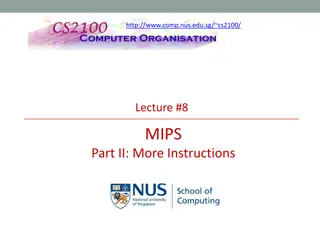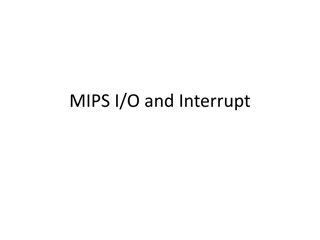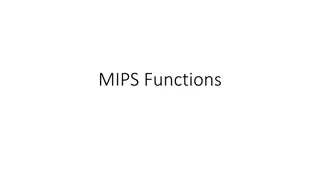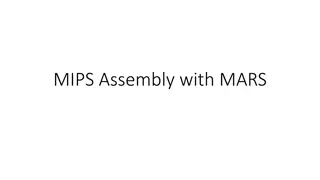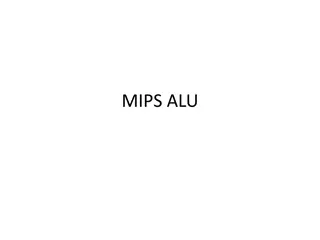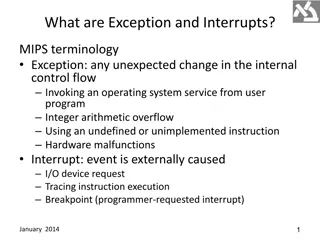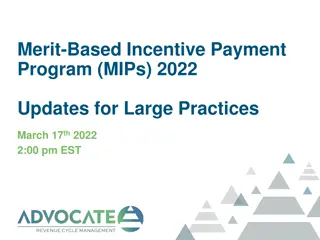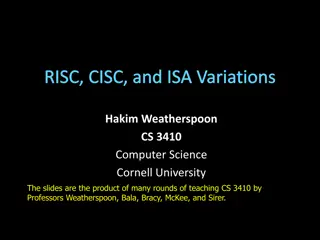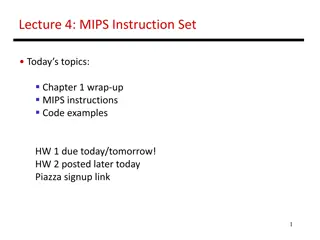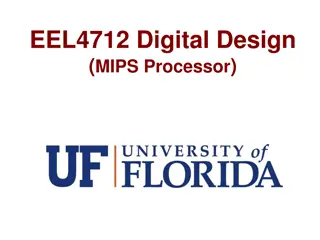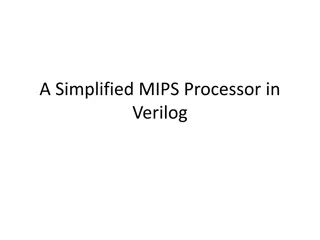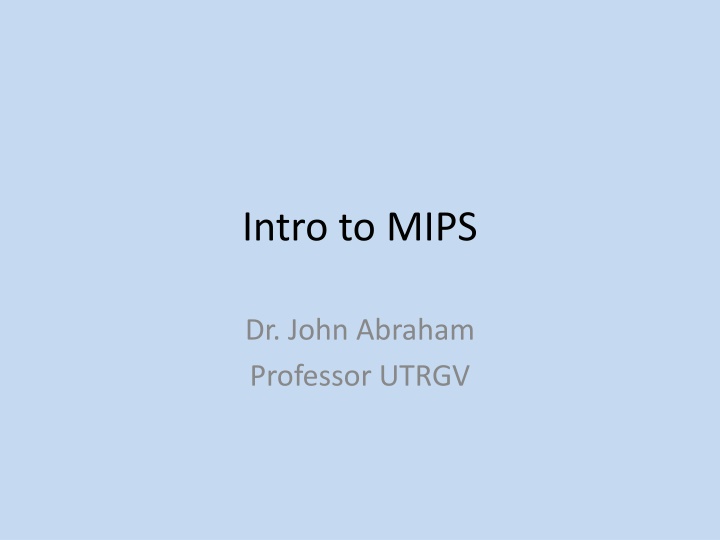
Introduction to MIPS and Program Setup for Assembly Coding
Learn about the basics of MIPS architecture, skipping through some chapters and focusing on pipelining. Get started with MARS simulation, understand registers, and create your first MIPS program to add two numbers. Explore useful information about MIPS commands and directives.
Download Presentation

Please find below an Image/Link to download the presentation.
The content on the website is provided AS IS for your information and personal use only. It may not be sold, licensed, or shared on other websites without obtaining consent from the author. If you encounter any issues during the download, it is possible that the publisher has removed the file from their server.
You are allowed to download the files provided on this website for personal or commercial use, subject to the condition that they are used lawfully. All files are the property of their respective owners.
The content on the website is provided AS IS for your information and personal use only. It may not be sold, licensed, or shared on other websites without obtaining consent from the author.
E N D
Presentation Transcript
Intro to MIPS Dr. John Abraham Professor UTRGV
Motivation We are in Chapter 8 now. We will be skipping Chapters 9, 10 and 11. You learned these in other courses. Chapter 9 deals with number systems, Binary, Octal, hexadecimal and decimal. Chapter 10 deals with Computer Math, signed and unsigned integers, and floating point. Chapter 11 deals with digital logic, Boolean, combinational circuits, adders, and flip-flops. We are going to discuss Pipelining in Chapter 13. It is important you will be ready for that chapter. Thus we will start with MIPS. There will be some lab assignments on this topic.
Download MARS Make sure you have JAVA installed. Please go to http://courses.missouristate.edu/kenvollmar/ mars/ After download I moved it to desktop and ran directly from there. Looks something like this: Next slide shows how it runs.
Registers showing only few There are 32 integer and 32 floating point registers. MIPS ONLY USES REGISTERS. VARIABLES WILL HAVE TO BE BROUGHT INTO REGISTERS FIRST. Feel free to use $t1 temporary registers. See next slide to learn more about integer registers.
MIPS program You should start by creating a new program from dropdown menu File Two parts Data Txt If you recall we have been writing assembly for C=A+B; we will do the same as your first MIPS MARS program.
Useful Information about MIPS Comment # Assembler directive .data, .asciiz, .global Operation mnemonic add, addi, lw, bne Register name $10, $t2 Address label (decl) hello:, length:, loop: Address label (use) hello, length, loop Integer constant 16, -8, 0xA4 String constant "Hello, world!\n" Character constant H , ? , \n
.Data section Contains all variables and values you want to provide to the program. You also need to provide data types For example .asciiz \nThis program adds two numbers\n firstNum: .word 594 secondNum: .word 816 oneChar: .byte y Pi: .float 3.14
Hello world program # Description: A simple hello world program! .data # add this stuff to the data segment hello: .asciiz "Hello, world!" # load the hello string into data memory .text # now we re in the text segment li $v0, 4 # set up print string syscall la $a0, hello # argument to print string syscall # tell the OS to do the syscall li $v0, 10 # set up exit syscall syscall # tell the OS to do the syscall
Some explanation li $v0, 4 -- load immediate 4 into $v0 Look at the help I gave along with the assignment, which shows $v0 values and what they mean. For example, if it is a 1 it expects to print an integer in $a0 (argument register 0). In our hello world example, we are placing a value of 4 in $v0 and the string in $a0 Syscall asking operating system to perform the above code.
Service Code in $v0 Arguments Result $a0 = integer to print print integer 1 $f12 = float to print print float 2 $f12 = double to print print double 3 $a0 = address of null- terminated string to print print string 4 $v0 contains integer read read integer 5 $f0 contains float read read float 6 $f0 contains double read read double 7
2 ways to get a number in the register # first way to put in RAM .data aNum: .word 300 .text lw $t1, aNum # and then bring to register li $v0, 1 addi $a0,$zero, 100 #second way to use addi add $a0, $a0, $t1 syscall 400

